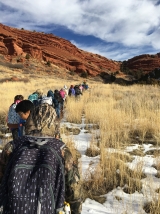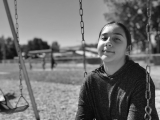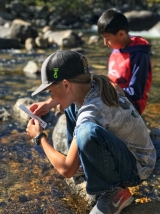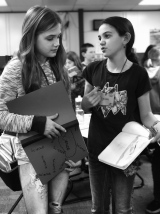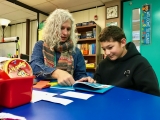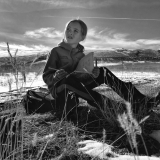-
Category 3
Selected in 2018
-
Grades: 4 - 5
School Setting: rural
Town Population: 7,500
Student Enrollment: 307
Student Demographics:
Black/African American: 6.8%
Teacher/Student Ratio: 1:20
White/Caucasian: 69%
Hispanic: 6.8%
Hawaiian/Pacific Islander: 0%
Asian: 0.3%
Native American: 11%
Other: 6%
% Reduced Lunch: 41%
% ELL Learners: 3%
Founded: 2011 -
PRINCIPAL:
Jade Morton -
CONTACT:
350 Smith Street
Lander, WY 82520
307-332-6967
jmorton@landerschools.org
Baldwin Creek Elementary School
Lander, WY
Our school’s culture is defined by our mission statement “Every Bobcat, Every Day!”
- Describe specific programs in place to ensure that families are involved in the success of your school and students.
-
We value our learning community and work very hard to ensure families are informed and feel welcome in our building. Again, the belief that we are a Professional Learning Community extends to our families. We offer multiple opportunities such as education/engagement nights, Parents In Education opportunities, guided classroom volunteering, literacy nights, cultural opportunities, multiple student council sponsored events and opportunities to serve within building leadership teams. Because we are a standards-based grading and reporting district, we are very cognizant of being transparent with the evidence each child has produced. We are very explicit with our feedback to students’ families through our standards-based report cards and we support parents through standards-based education nights. We also conduct annual climate surveys to ensure our families feel they have a voice at Baldwin Creek. We use that valuable information to analyze our pedagogical practices and make changes or celebrate successes at Baldwin Creek Elementary to ensure a positive environment.
- Describe the most successful activity your school has initiated to strengthen ties to your community.
-
Lander, Wyoming is a very unique community built upon its diversity that is defined by its socioeconomics, geography, culture, and ethnicity. As a Title I school, Baldwin Creek Elementary has embraced our diversity and has enriched our students and learning community by a series of outreach programs and community engagement in our schools. We feel it’s not only important to reach out to our stakeholders, but we also want our students to understand and embrace the place we call home. We partner with the Bureau of Land Management, Central Wyoming College, Game and Fish, National Outdoor Leadership School, Promoting Art in Lander Schools, Sinks Canyon State Park, Teton Science School and many other local groups and agencies to give our students exclusive opportunities only these groups can provide outside of the classroom. We partner with the Eastern Shoshone and Northern Arapaho Native American tribes so that our students have opportunities to learn about our cultural aspects and embrace our diversity as a learning community. We work closely with our school district’s Native American liaison to ensure we are meeting the needs of all of our students. Our student council gets involved in community interactions, supports local organizations and brings in community members to interact with our school. The Bobcat News Team is a very impressive enrichment program that composes a weekly production of school news that is broadcasted on Youtube and our district website. It provides an in-depth look into student life at Baldwin Creek Elementary and keeps us connected to the community at yet another level and is a Professional Learning Community (PLC) on a grand scale.
- Describe your philosophy of school change or improvement.
-
Our mission is to ensure that all students learn at high levels both academically and socially. Therefore, as we examine our students’ needs through qualitative and quantitative data sources, we embrace change as a way to refine our practices and support our students. As we prepare for change, school leadership teams work together to identify and support the cultural shifts that will be necessary for implementation (building shared knowledge, professional development, working with stakeholder groups, etc.) as well as the technical details (schedule changes, data collection processes, communication plans, etc.) Finally, we know that change takes time. We work to make change meaningful, data-driven, and doable for the people responsible for implementation.
- What are your school’s top two goals for the next year?
-
There are many goals ahead for the Baldwin Creek team. Goals include: continue professional development, work in our Professional Learning Communities, and target instruction across all tiers of RTI to increase the percent of students proficient to 80% and, therefore, decrease the number of students needing Tier III interventions to 20% of the Baldwin Creek student population: in this way further closing the achievement gaps for all Culturally and Linguistically Diverse Learners, English Language Learners, Special Education, and Title 1 students.
Begin home-visits to compile and collect every “At Promise” students Funds of Knowledge.
- What is the single most important factor in the success of your school that others could replicate?
-
The undeniable practice of believing that all of our Bobcats can learn at high levels is the single most important factor of our success. Because we live that belief each day, everything else falls into place. Again, our culture of belonging sets the stage that all students are valued and welcome. That feeling instills the confidence that they have the supports needed both academically and emotionally to achieve at high levels. Once we have the students tied into the culture, we then go to work on meeting their comprehensive needs. After we've exhausted assessing the student's performance, we use that evidence and analyze it in our collaborative teams. Through the PLC process, we tap into MTSS to ensure that students have every opportunity to achieve at the high levels we expect our Bobcats can. It is through the explicit instruction and expectations laid out by our priority standards, CFAs, CSAs and proficiency scales that our learning community targets which course of action will best answer the four critical questions: what is it we expect our students to learn? how will we know when they have learned it? how will we respond when some students do not learn? how will we respond when some students already know it?
- Describe the program or initiative that has had the greatest positive effect on student achievement, including closing achievement or opportunity gaps, if applicable.
-
First and foremost the entire staff at Baldwin Creek Elementary has a heart for students and desires the very best for each one. In the words of a fifth-grade teacher, “One quality an effective teacher must possess is a love for kids. All kids.” From the moment our students and their families walk in the door and are greeted by our Administrative Assistant; the process of identifying and providing for the unique needs of every Bobcat begins. When a child is struggling academically or behaviorally our Building Intervention Team (BIT) convenes. A panel of specialists including our dropout prevention coordinator, general education teachers, Native American liaison, principal, school counselor, school nurse, school psychologist, special education specialists, paraprofessionals, speech and language pathologists, and Title 1/Reading specialist. This multidisciplinary team coordinate and in various ways acts on “At Risk” student information and data that is recorded in our district platform, Milepost. Student’s Milepost records include state and district assessments, interventions, BIT and 504 plans and follow students from grades K-12.
- Explain how ESEA federal funds are used to support your improvement efforts.
-
At Baldwin Creek Elementary, we utilize funds to support our students and staff at many different levels. We maximize our Title I Reading Specialist to ensure we are meeting our students’ needs by chairing many leadership roles and providing high-quality instruction. She not only delivers her instruction through targeted interventions, but she also ensures they are provided services through Multi-Tiered Systems of Support (MTSS). She also works with our students during summer school to continue targeted instruction through those critical months and, therefore, the chance for regression decreases. We’ve also invested in a highly effective Early Language Specialist, an Instructional Coach, and Math Specialist. These specialists, and team members, are highly trained in multiple interventions and are an intricate part of an impressive intervention team that collaborates with our special education team members and has been key to our students’ success. Additionally, we utilize funds to provide multiple opportunities for professional development to support our Professional Learning Community. Because of Title I resources, our entire staff has a myriad of opportunities for training through conferences, PLC institutes, guest trainers, coaches and a multitude of online resources. We also support a highly engaging "Specials" team comprised of art, music, PE, library/media and character traits to add another layer of connectivity to Baldwin Creek Elementary.
- Identify the critical professional development activities you use to improve teaching and student learning.
-
In order to meet the academic and social needs of our students, we are committed to embedded, ongoing adult learning. Classroom teachers, special education teachers, related service providers, paraprofessionals, and content-area specialists all serve on one of our teams working collaboratively to build shared knowledge and refine our practices. This collaboration prompts collective inquiry through team-selected professional development (PD) such as book studies, action research, and attending in- and out-of-district PD. The district also supports ongoing PD through a once-a-week early release schedule that allows for school-wide PD. Decisions are made by determining if the PD will support staff in meeting student needs and if it supports the overall vision for our school. Instructional and Team Coaching is provided throughout implementation. Currently, PD is focused on developing ourselves as a Professional Learning Community and meeting the social-emotional needs of our students.
- Describe how data is used to improve student achievement and inform decision making.
- At a building-wide level, our focus is on Language Arts and Math priority standards. At a Tier I level, general education staff and specialists meet frequently to analyze student data. Students at the Tier II level are grouped by-student-by-standard (Buffum et al., 2012) based upon current performance on grade level Common Formative Assessments (CFA) and Common Summative Assessments (CSA). At a Tier III level, each students’ data from state standardized tests and district common assessments such as state standardized assessments, STAR Reading, and STAR Math are gathered and compared for every student at Baldwin Creek. Student’s grades and general education teacher observations and anecdotal notes are included in this data collection. A student performing at or below the 40th. percentile is targeted for further diagnostics and possible intervention. Special Education and Title 1 departments coordinate to provide skill-based interventions that are research and evidenced based.
- Describe your school culture and explain changes you’ve taken to improve it.
-
Our school’s culture is defined by our mission statement “Every Bobcat, Every Day!” and is the creed we live by. Our school culture is special! Truly, our staff believes that all students can learn at high levels. We work very hard in our collaborative teams to ensure we have wrap-around services for each student and we focus on the “whole” child. Our high standards of creating a welcoming environment start as you enter our building. Through a series of welcoming cues and positive interactions, we set the stage of belonging to our school community. Our school and district have a shared belief and commitment that through our Professional Learning Community we will answer the four critical PLC questions to the best of our ability. Because of our commitment, our culture has grown into a “whatever it takes” building focused on differentiating our approach to meet the needs of our students. We infuse Social Emotional Learning (SEL) class delivered by our amazing school counselor to each student one hour per week. The SEL curriculum compliments our school’s Positive Behavior Incentives program and Tier I classroom systems to ensure students feel safe and supported while gaining valuable strategies for addressing social and emotional needs. We believe in instilling hope, perseverance, grit, and positivity in order for our students to have the confidence needed to achieve in the 21st Century. We take time to celebrate our staff and students successes through assemblies, media, and building celebrations.
Stats
-
Category 3
Selected in 2018
-
Grades: 4 - 5
School Setting: rural
Town Population: 7,500
Student Enrollment: 307
Student Demographics:
Black/African American: 6.8%
Teacher/Student Ratio: 1:20
White/Caucasian: 69%
Hispanic: 6.8%
Hawaiian/Pacific Islander: 0%
Asian: 0.3%
Native American: 11%
Other: 6%
% Reduced Lunch: 41%
% ELL Learners: 3%
Founded: 2011 -
PRINCIPAL:
Jade Morton -
CONTACT:
350 Smith Street
Lander, WY 82520
307-332-6967
jmorton@landerschools.org


